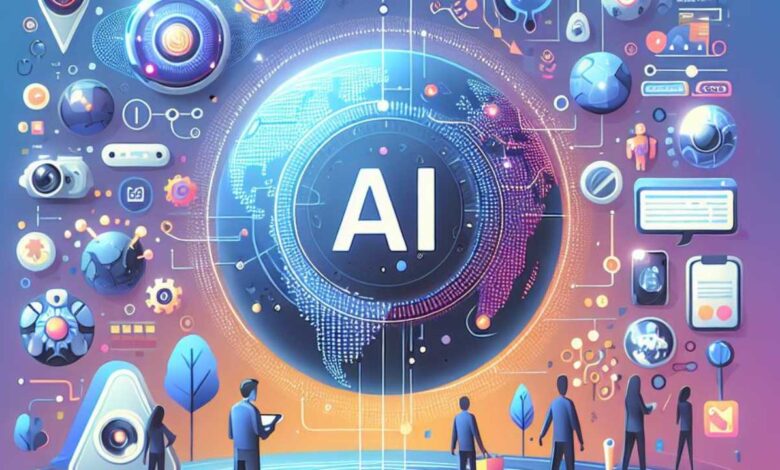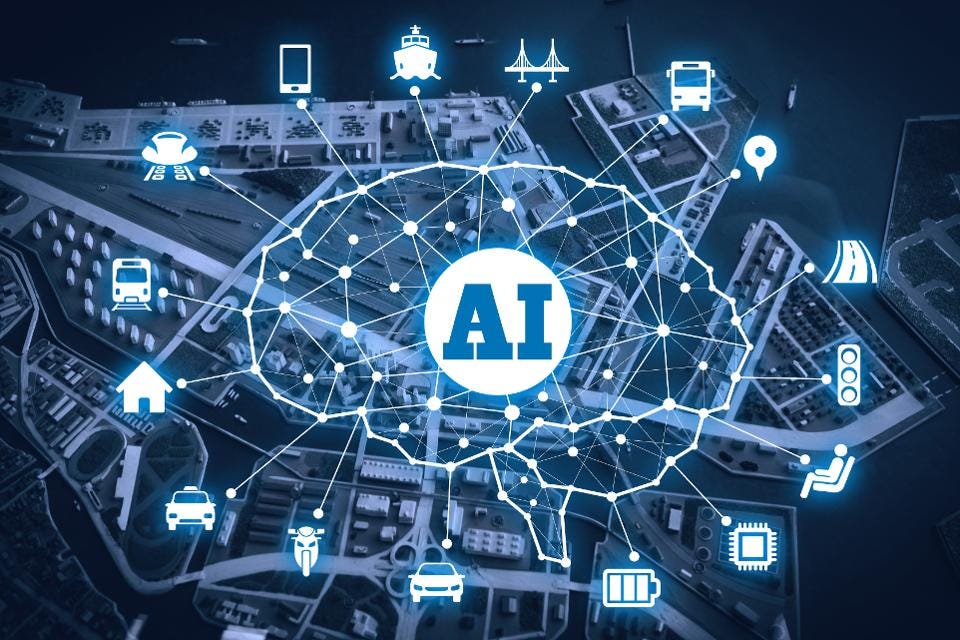AI in Everyday Life: How Artificial Intelligence is Quietly Reshaping Our World

AI in Everyday Life Artificial Intelligence, or AI, has gone from being a futuristic buzzword to something we live with every single day. Most of us don’t even realize how often we interact with AI, because it’s seamlessly blended into apps, devices, and services we use without a second thought. From scrolling through social media to commuting to work, AI is quietly running the show behind the scenes. But what does AI in everyday life really look like, and how does it affect us on a practical level? Let’s take a deep dive into it.
AI in Communication: Smarter Conversations Everywhere

One of the most obvious ways AI in Everyday Life shows up in our lives is through the way we communicate. Think about how often you interact with AI in Everyday Life tools without even realizing it.
Take voice assistants, for example. Siri, Alexa, and Google Assistant are essentially little AI in Everyday Life helpers living in our phones and smart speakers. They recognize natural language, process requests, and give us instant responses—whether it’s setting a reminder, checking the weather, or even telling a joke. It’s a far cry from the robotic systems of the past, where you had to say commands in very specific ways.
AI in Everyday Life is also at the core of how we write and message. Autocorrect, predictive text, and smart replies in emails are all powered by machine learning. These systems analyze millions of examples of language and learn how people usually respond. Over time, they get better at predicting what you’re about to type, saving you a few seconds with every message. It might feel like a small convenience, but collectively, it makes communication faster and smoother than ever.
And then there’s translation. AI in Everyday Life apps like Google Translate now make it possible to have real-time conversations with people who speak different languages. That’s something that used to require a human translator, but now we have software doing it instantly. This globalizes communication in ways our grandparents couldn’t have imagined.
AI in Entertainment: Personalized Fun at Your Fingertips
Entertainment has been transformed by AI in Everyday Life in a way that feels almost magical. Ever wondered how Netflix always seems to know what you’ll want to watch next? Or how Spotify builds playlists that fit your mood perfectly? That’s AI recommendation systems at work.
These platforms use machine learning to analyze your history—what you’ve watched, liked, skipped, or replayed—and then compare it with millions of other users’ habits. The AI in Everyday Life finds patterns and predicts what you’re most likely to enjoy next. This keeps you engaged and makes it easier than ever to find new favorites without endless scrolling.
Gaming has also been heavily influenced by AI in Everyday Life. Non-playable characters (NPCs) in video games are now much smarter, reacting to player decisions in realistic ways. AI helps create adaptive gameplay, meaning your experience evolves based on your actions. Some AI even designs game environments or storylines dynamically, so no two players have exactly the same adventure.
And let’s not forget social media. Whether you’re on TikTok, Instagram, or YouTube, the algorithm (powered by AI in Everyday Life) decides which content appears on your feed. The scary but fascinating part is how accurate these systems can be. They know what will catch your attention before you even do, which is why you often lose track of time scrolling.
AI in Shopping: Smarter Choices and Faster Service
AI in Everyday Life has become a silent shopping assistant for millions of people around the globe. The most obvious example is product recommendations. When you browse Amazon, the “You might also like” or “Frequently bought together” suggestions aren’t random—they’re powered by AI analyzing buying patterns.
Customer service has also gotten an AI in Everyday Life upgrade. Chatbots are now common on e-commerce websites, answering questions about shipping, returns, or product details. While they’re not perfect, they can handle most basic queries instantly, which saves time for both customers and companies.
AI in Everyday Life is also used in fraud detection for online shopping. Every time you make a purchase, AI systems run in the background to make sure it’s really you and not a hacker using stolen credit card information. This adds a layer of security that most of us don’t even think about, but it’s crucial in today’s digital economy.
The personalization doesn’t stop at product recommendations. Retailers use AI in Everyday Life to predict trends and manage stock. Ever noticed how a certain fashion item seems to go viral and suddenly appears everywhere? That’s not just chance—it’s AI helping brands understand what people want before they even know it themselves.
AI in Transportation: From GPS to Self-Driving Cars
If you’ve used Google Maps or Waze, you’ve already relied on AI in Everyday Life. These apps don’t just show you directions—they predict traffic patterns, reroute based on accidents, and even estimate your arrival time with remarkable accuracy. They collect massive amounts of real-time data from millions of users, which AI processes to help everyone move more efficiently.
Ride-hailing apps like Uber and Lyft also use AI in Everyday Life to match drivers with passengers, estimate fares, and optimize routes. It’s all happening in seconds, but the algorithms are crunching enormous amounts of data to make your ride smooth and cost-effective.
And then, of course, there’s the big one: self-driving cars. While fully autonomous vehicles are still being tested and fine-tuned, the fact that we already have cars with lane-assist, automatic braking, and parking assistance shows how far AI in Everyday Life has come in transportation. These features aren’t just convenient—they’re also making driving safer by reducing human error.
AI in Healthcare: Better Diagnosis and Personalized Care
Healthcare is another area where AI in Everyday Life is quietly but powerfully making a difference. Doctors are now using AI-powered systems to analyze X-rays, MRIs, and other scans more quickly and accurately than ever before. These systems can spot patterns that even trained human eyes might miss, leading to earlier and more reliable diagnoses.
Personalized medicine is another breakthrough. AI in Everyday Life can analyze your health history, genetic information, and lifestyle data to recommend treatments that are specifically tailored to you. This means medicine is moving away from a one-size-fits-all model to something much more precise.
Even outside hospitals, AI in Everyday Life is helping. Fitness trackers and smartwatches use machine learning to monitor heart rate, sleep, and activity levels, giving people real-time health insights. Some can even alert users to potential heart problems before they become serious, potentially saving lives.
AI at Home: Making Daily Life Easier
Smart homes are perhaps the most visible example of AI in everyday life. From smart thermostats that learn your temperature preferences to refrigerators that track expiration dates, AI makes homes more convenient and energy-efficient.
Home security systems also rely on AI in Everyday Life, with cameras that can distinguish between a person, an animal, or just a swaying tree branch. This reduces false alarms and makes it easier for homeowners to monitor their properties remotely.
Even cleaning has been revolutionized. Robotic vacuum cleaners use AI in Everyday Life mapping to navigate around furniture and clean efficiently without constant human input. It might not seem groundbreaking, but when you realize how much time it saves, you start to appreciate the value of small-scale AI.
The Benefits and Challenges of AI in Everyday Life
The benefits of AI in Everyday Life are clear: convenience, efficiency, personalization, and even safety. It saves us time, helps us make smarter decisions, and sometimes even entertains us better than human-made systems could.
But it’s not all sunshine and rainbows. AI in Everyday Life also brings challenges. Privacy is a big concern, since AI relies on collecting and analyzing massive amounts of personal data. Bias in algorithms is another issue—if AI systems are trained on flawed data, they can produce unfair or discriminatory outcomes. And of course, there’s the fear of over-reliance, where humans might lose certain skills because we’ve handed too much over to machines.
Balancing the benefits with the risks is key. As users, we need to stay aware of how much information we’re giving up and push for ethical standards in AI in Everyday Life development.
Final Thoughts
AI in everyday life isn’t just the future—it’s the present. From the moment we wake up to the moment we go to sleep, AI is quietly guiding our routines, making life easier, smarter, and more efficient. Whether it’s through communication tools, shopping, healthcare, or entertainment, AI has become woven into the fabric of modern living.
The exciting part is that we’re only scratching the surface. As AI in Everyday Life continues to evolve, we’ll see even more integration into areas we haven’t yet imagined. While it’s important to remain cautious about issues like privacy and ethics, the potential for AI to improve lives is enormous.
So the next time your phone suggests the perfect playlist, your car finds the fastest route, or your watch reminds you to stand up and stretch, remember: AI in Everyday Life is already living with you—and it’s here to stay.



